In the realm of insects that strike fear in homeowners, wasps undoubtedly claim a prominent spot. Their disturbing presence and painful stings can turn even the most peaceful outdoor activities into nerve-wracking encounters. Among the various types of wasps, one particular species stands out—the bull wasp. Sometimes referred to as "white-faced hornets", "bald-faced hornets", or "blackjackets", bull wasps are true wasps, despite their many misnomers. We aim to shed light on these formidable insects, from their distinct characteristics and nesting behaviors to the potential impact they have on homeowners. By understanding the nature of bull wasps, you'll gain valuable insights to navigate encounters with them, ensuring your safety and peace of mind.
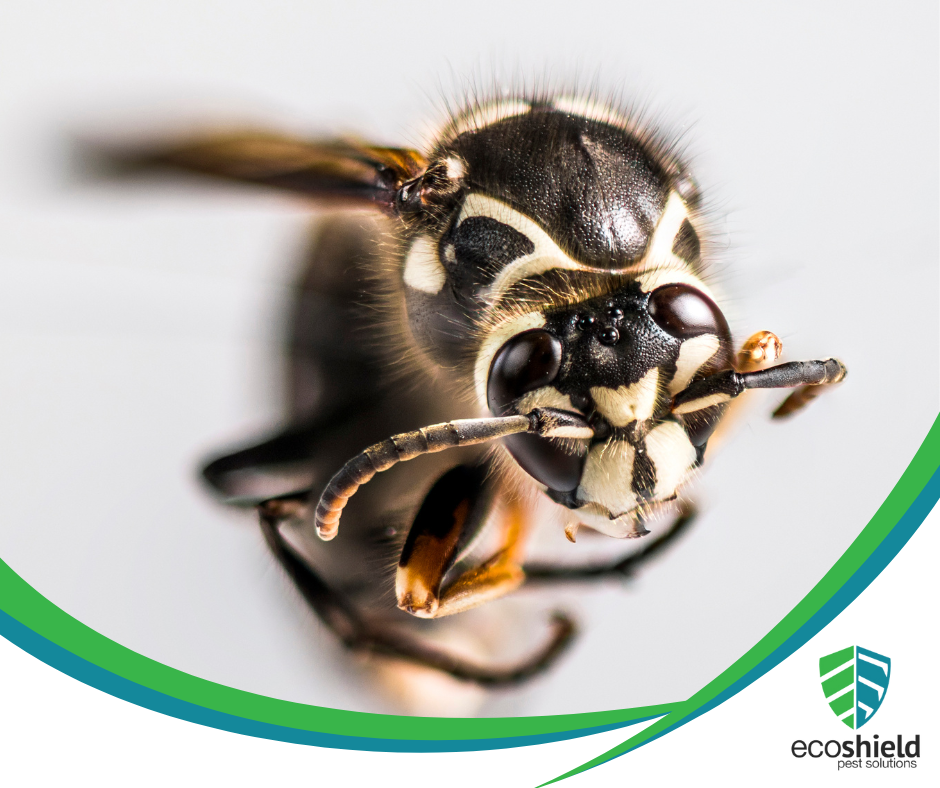
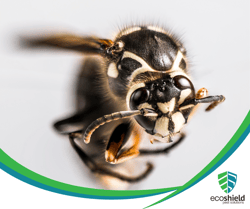
What are the differences between stinging insects?
Wasps, hornets, and bees—three buzzing creatures that often cause confusion due to their similar appearances and shared reputation for stinging. However, these winged insects belong to distinct species, each with its own characteristics and behaviors. Understanding the differences between wasps, hornets, and bees is not only fascinating but also essential for our coexistence with these potentially dangerous creatures.
Let's start with wasps. These insects are part of the family Vespidae and are known for their slender bodies, narrow waists, and smooth, shiny skin. Wasps come in various species, including yellowjackets, paper wasps, and bull wasps, and are generally aggressive and territorial. They are scavengers and predators, feeding on other insects, fruits, and nectar. Wasps often build paper-like nests, usually in protected areas like eaves, attics, or shrubs.
Moving on to hornets, which are a type of wasp belonging to the genus Vespa. What sets hornets apart is their larger size and more potent sting compared to other wasps. With their robust bodies and characteristic brown or black coloration, hornets are fearsome predators. They primarily feed on other insects, making them beneficial in controlling pest populations. Hornets construct their nests in elevated locations, such as trees, and their colonies can be significantly larger than those of wasps.
Now, let's turn our attention to bees. Bees belong to the family Apidae and are crucial pollinators for many plants and crops. Unlike wasps and hornets, bees are generally more robust and covered in dense hair, providing better pollen collection and transportation. They have a specialized diet of nectar and pollen. Bees form complex social colonies with a queen, worker bees, and drones. Their nests, known as beehives, consist of wax combs built by the bees themselves.
The primary distinction between wasps, hornets, and bees lies in their behavior, ecological roles, and nesting habits. Wasps and hornets tend to be more aggressive and can sting multiple times when provoked, whereas bees are less aggressive and typically sting only once before losing their stinger and dying. Furthermore, bees play a vital role in pollination, supporting plant reproduction, while wasps and hornets are valuable for pest control by preying on other insects.
In conclusion, while wasps, hornets, and bees share some similarities, such as their ability to fly and sting, they are distinct species with unique characteristics. Understanding these differences helps us appreciate the roles these insects play in our ecosystems, as well as better understand the potential threat they may pose to human safety. So, the next time you encounter a buzzing creature, take a moment to observe its features and behaviors, and you'll be better equipped to appreciate the diversity and importance of these often-feared insects.
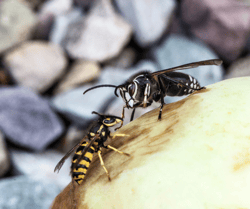 Bull wasp and Yellowjacket feuding over a fallen apple.
Bull wasp and Yellowjacket feuding over a fallen apple.
What are bull wasps?
Bull wasps, scientifically known as Vespa orientalis, are a species of social wasps that belong to the Vespidae family. Originating from parts of Asia and Africa, bull wasps have spread to various regions worldwide, often becoming a nuisance for homeowners due to their aggressive nature and territorial behavior.
In terms of appearance, bull wasps are notable for their robust physique and intimidating size. They are considered one of the largest wasp species, measuring up to 1.5 inches in length. Their bodies exhibit a distinctive coloration characterized by dark brown, black, white, and yellow markings, which further adds to their unmistakable appearance.
Bull wasps are highly territorial insects, fiercely defending their nests and displaying aggressive behavior when threatened. They have a potent sting and can sting repeatedly, making encounters with them particularly daunting for homeowners. Additionally, bull wasps have the ability to mobilize a swarm of fellow wasps in defense, escalating the intensity of their response.
Nesting habits of bull wasps typically involve constructing nests in protected areas, such as under eaves, in attics, or within shrubs and trees. These nests are often made of a papery material created by chewing wood fibers mixed with their saliva. The nests can grow substantially, accommodating a colony of bull wasps.
The impact of bull wasps on homeowners can be significant. Firstly, their aggressive behavior can disrupt outdoor activities, making it challenging to enjoy a peaceful time in your garden or backyard. Their territorial nature may lead to frequent encounters and the risk of painful stings. Furthermore, individuals with allergies to wasp venom need to be particularly cautious, as a bull wasp sting can trigger severe allergic reactions that require immediate medical attention. It's crucial to be aware of the signs and symptoms of an allergic reaction and seek prompt medical help if necessary.
Bull wasps can also cause damage to structures and property. Their nesting habits may lead them to construct nests in or around homes, potentially leading to structural damage over time. Additionally, if bull wasps gain access to indoor areas, they can become a nuisance and create a safety hazard for residents.
Given their impact on homeowners, it is essential to proactively manage bull wasp infestations. Identifying signs of nest construction, such as an increase in wasp activity or the presence of papery nests, is crucial for early intervention. Seeking professional assistance from pest control services can help safely remove nests and implement preventive measures to minimize future encounters.
Bull wasps are formidable insects with a rugged appearance and aggressive behavior. Their territorial nature, potent sting, and nesting habits can pose challenges for homeowners. By understanding their biology, appearance, nesting habits, behavior, and impact, homeowners can take proactive steps to manage bull wasp encounters, ensuring a safer and more harmonious living environment.
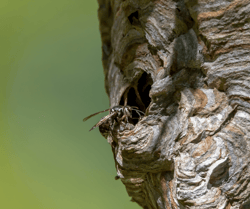 Bull wasp nests are often made of a papery material created by chewing wood fibers mixed with their saliva.
Bull wasp nests are often made of a papery material created by chewing wood fibers mixed with their saliva.
Can I prevent bull wasps in or around my home?
Yes! At EcoShield, we believe prevention is the best first-line defense against unwanted pests like bull wasps. Luckily, you can take preventive measures to reduce the likelihood of bull wasps nesting in or around your home. Here are some steps you can follow to help prevent bull wasps:
- Seal potential entry points: Inspect your home for gaps or openings that bull wasps could use to gain access. Seal cracks, crevices, and gaps in windows, doors, and walls using caulk or weatherstripping.
- Keep windows and doors screened: Install tight-fitting screens on windows, doors, and vents to prevent bull wasps from entering your home while allowing airflow.
- Remove food sources: Bull wasps are attracted to food and sugary substances. Keep outdoor eating areas clean and promptly clean up food spills. Ensure trash cans have tight-fitting lids, and regularly empty and clean them.
- Trim vegetation: Bull wasps are attracted to dense foliage and shrubs. Trim trees, shrubs, and vegetation around your home to minimize potential nesting sites. Ensure branches and plants are not in direct contact with your house.
- Limit water sources: Bull wasps need water for survival. Eliminate standing water sources, such as birdbaths, stagnant pools, or leaky outdoor faucets, as these can attract them. Ensure gutters are clear of debris and properly draining to prevent water accumulation.
- Secure garbage and compost bins: Keep garbage and compost bins tightly closed and regularly clean them to minimize odors that can attract bull wasps.
- Avoid attracting other insects: Bull wasps prey on other insects. Minimize the presence of insects around your home by keeping outdoor lights off at night or using yellow or sodium vapor lights, as these are less attractive to insects.
- Consult with a professional pest control service: If you notice signs of bull wasp activity or have had previous infestations, we highly recommend seeking assistance from a professional pest control service. They can assess your property, provide recommendations tailored to your situation, and safely remove nests if necessary.
Remember, if you encounter a bull wasp nest or suspect an infestation, it's important to exercise caution and avoid disturbing it yourself. Bull wasps can become aggressive when their nest is threatened. It's best to rely on professionals who have the necessary expertise and protective gear to handle nest removal safely.
By implementing these preventive measures, you can reduce the likelihood of bull wasps establishing nests in or around your home, creating a safer and more comfortable environment for you and your family.
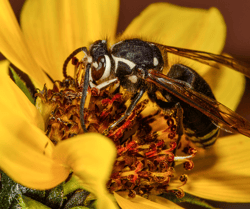 Bull wasps are attracted to dense foliage and shrubs.
Bull wasps are attracted to dense foliage and shrubs.
What should I do if I have a bull wasp infestation?
If you have a bull wasp infestation in or around your home, don’t panic! Just understand that it's crucial to take appropriate action to address the situation. Here are some steps you should consider if you're dealing with a bull wasp infestation:
- Identify the nest: Carefully observe the bull wasp activity to locate the nest. Bull wasps typically build nests in protected areas, such as eaves, attics, trees, or shrubs. Identifying the nest will help you determine the extent of the infestation and plan the necessary steps for removal.
- Keep your distance: It's important to avoid approaching or disturbing the nest as bull wasps can become aggressive and sting when threatened. Ensure children and pets are kept away from the infested area.
- Seek professional help: Given the potentially dangerous nature of bull wasp infestations, it's recommended to contact a professional pest control service experienced in wasp nest removal. They have the expertise, equipment, and protective gear to handle the situation safely and effectively.
- Follow professional advice: Once the pest control professionals arrive, they will assess the infestation, customize a removal plan, and implement the necessary measures. Follow their instructions and guidance to ensure a successful and safe resolution.
- Avoid DIY removal attempts: It's imperative that you resist the temptation of attempting DIY removal of the bull wasp nest. Without proper training and equipment, you risk provoking the wasps and putting yourself and others in danger. Professional pest control technicians are trained to handle such situations safely.
- Take post-preventive measures: After the infestation has been resolved, it's important to implement preventive measures to minimize the chances of future bull wasp infestations. Sealing entry points, keeping outdoor areas clean, and removing attractants can help deter bull wasps from returning.
Remember, bull wasp infestations can be hazardous, and attempting to remove the nest on your own without the necessary knowledge and protective gear can lead to stings and potential injury. Relying on professional pest control services ensures the problem is handled safely and efficiently. By contacting professionals, you can address the bull wasp infestation with minimal risk and prevent further inconvenience or potential harm caused by these aggressive insects.
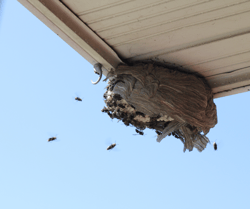 Bull wasps build nests in protected areas, such as eaves, attics, trees, or shrubs.
Bull wasps build nests in protected areas, such as eaves, attics, trees, or shrubs.
Can EcoShield Pest Solutions help me prevent and remove bull wasps?
Absolutely.
At EcoShield, we offer comprehensive solutions for preventing and removing bull wasp infestations. Our trained pest technicians have the expertise, equipment, and specialized techniques to address bull wasp infestations effectively and safely. EcoShield’s stinging insect service provides the expertise needed to effectively prevent and remove bull wasp infestations, ensuring the safety and comfort of your home and family. You can learn more about our stinging insect service here.
If you need expert bull wasp removal or simply would like to prevent bull wasps in or around your home, be sure to give EcoShield a call or fill out the form on this page for your free no-obligation inspection!